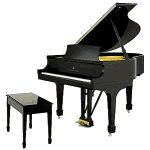

Choose the letter which begins musical term that you would like to learn about:
| A | B | C | D | E | F | G | H | I | J | K | L | M | N | O | P | Q | R | S | T | U | V | W | X | Y | Z |
MAbbreviation for mano or main, meaning hand.
M.M.Abbreviation for Maezel's Metronome.
MaBut. Used with other words, e.g. lento ma non troppo, slow but not too slowly.
MaggioreMajor, referring to mode.
MaestosoMajestically.
MainHand.
MajorThe designation for certain intervals and scale. A key based on a major scale is called a major key. The pattern for the major scale is:
whole whole half whole whole whole half step step step step step step step
Major chordA triad composed of a root, major third, and perfect fifth.
Major intervalsMajor intervals are from the tonic to the second, third, and perfect sixth and seventh degress as they occur in the major scale. Any minor interval enlarged by one semitone becomes a major interval.
Major Locrian ScaleSee Scales and chords.
MancandoFading away
MarcatoEmphasized, heavily accented.
MeasureA group of beats containing a primary accent and one or more secondary accents, indicated by the placement of bar lines on the staff. The space between two bar lines.
MedesimoThe same.
MediantThe third degree of the major of minor scale. The triad built on this degree is labeled iii in the major scale, III in the natural minor scale, and III+ in the harmonic minor scale.
MedievalThe period prior to the Renaissance, c. 500-1450, marking the music of the early Christian church.
MelodyIn general, a succession of musical tones. It represents the linear or horizontal aspect of music.
MenoLess.
Meno mossoLess motion.
MeterThe structure of notes in a regular pattern of accented and unaccented beats within a measure, indicated at the beginning of a composition by a meter signature.
Meter signatureThe numbers placed at the beginning of a composition to indicate the meter of the music. The upper number indicates the beats in a measure; the lower number tells what kind of a note will receive one beat. This is sometimes known as a Time Signature.
MetronomeInvented by Maelzel in 1816, the instrument is used to indicate the exact tempo of a composition. An indication such as M.M. 60 indicates that the pendulum, with a weight at the bottom, makes 60 beats per minute. A slider is moved up and down the pendulum to decrease and increase the tempo. M.M.
=80 means that the time value of a quarter note is the equivalent of one pendulum beat when the slider is set at 80.
MezzoHalf, Medium
Mezzo forteMedium loud.
Mezzo pianoMedium soft.
MiIn solmization, the third degree of the major scale.
Middle Ages
European historical period between roughly A.D. 500 and 1450. More about this time period.
Middle C
The note C in the middle of the Grand staff, and near the middle of the piano.
Minor
The designation for certain intervals and scales. A key based on a minor scale is called a minor key. The three types of minor scales include natural, harmonic, and melodic, which is used infrequently in choral music. The patterns for natural and harmonic scales are:
natural: whole half whole whole half whole whole step step step step step step step
harmonic: whole half whole whole whole 1-1/2 half step step step step step steps step
melodic:
| (ascending): | whole | half | whole | whole | whole | whole | half | ||
| step | step | step | step | step | step | step |
| (descending): | whole | whole | half | whole | whole | half | whole | ||
| step | step | step | step | step | step | step |
Misterioso
Mysteriously.
Mit
With.
Mode
Any scalewise arrangement of pitches; more generally, the term refers to the patterns upon which medieval music was structured, the patterns which preceded the development of major and minor scales and tonality.
Moderato
Moderate speed.
Modern
Music written in the Twentieth century or contempory music.
Modulation
The process of changing from one key to another within a composition.
Molto
Very. Used with other terms, e.g. molto allegro.
Mordent
"Biting." An ornament consisting of an alteration (once or twice) of the written note by playing the one immediately below it (lower mordent), or above it (upper, or inverted, mordent) and then playing the note again.
Morendo
Gradually decreasing in volume; dying away.
Mosso
Rapid. Meno mosso, less rapid. Piu mosso, more rapid.
Motive
A short melodic or rhythmic pattern.
Moto
Motion. Con moto, with motion.
Movable Do
Generally any system of solmization so designed that the syllables can be used in transposition to any key; "Do" remaining as the tonal center, regardless of key.
Music
The organization of sounds with some degree of rhythm, melody, and harmony.
Music theory
The study of how music is put together.
 |

|
| A | B | C | D | E | F | G | H | I | J | K | L | M | N | O | P | Q | R | S | T | U | V | W | X | Y | Z |
Belwin Pocket Dictionary of Music: Music Theory Dictionary
By Dr. William Lee
Students may purchase a copy for home use at cost
Many thanks to Dearest for everything!
is located
in Fairfax, Virginia
Over 30 Years
~~
Piano, Organ
Electric Keyboard
Accompanying
All rights reserved.
Site design and maintenance by
O'Connor O'Riginals Web Design